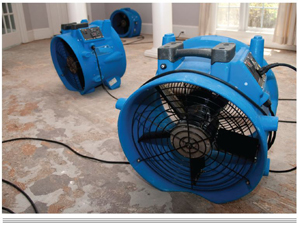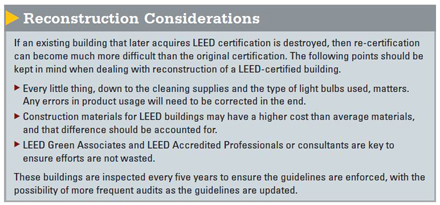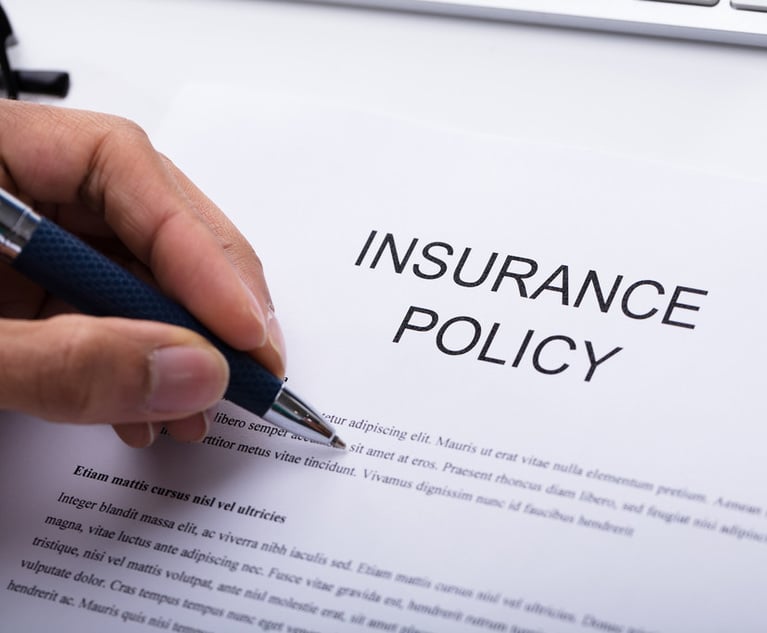 Leadership in Energy and Environmental Design (LEED) is aninternationally recognized green building certification systemdeveloped by the U.S. Green Building Council(USGBC).
Leadership in Energy and Environmental Design (LEED) is aninternationally recognized green building certification systemdeveloped by the U.S. Green Building Council(USGBC). Over the past decade, LEED certification has become an increasingly popular objective for builders and owners ofcommercial and residential properties. According to the USGBC, morethan 36,000 commercial projects and 38,000 single-family homes havealready participated in LEED since the rating system was firstintroduced in 2000. The volume of participating properties isenormous—about six billion square feet of projects are registered,and developers of another six billion square feet of projects arecurrently pursuing certification.
|Although claims adjusters are generally familiar with the LEEDconcept, relatively few among them possess comprehensive knowledgeof how LEED certification affects the recovery process following adisaster, such as a flood or fire. This knowledge gap creates risksfor both the insured and the insurer, but adjusters can close thatgap by more carefully assessing how restoration of an insuredLEED-certified property differs from disaster recovery for realestate not certified by LEED.
|Expensive RestorationRisks
|Although most LEED rating systems do not require periodicrecertification audits, there is an exception in the case of LEEDfor Existing Buildings (LEED EB): Operations and Maintenance(O&M). This certification, which encompasses maintenanceprograms, energy and water usage, waste management, and indoorenvironmental quality, is performance-based, and requiresrecertification every five years.
|The bad news—which few adjusters are aware of and even feweraddress—is that if an LEED EB: O&M-rated building experiences adisaster, it is at risk of losing its LEED certification unless itis restored with a rating-appropriate approach. For example, if abuilding's HVAC system is damaged, and a company replaces it withan inferior or alternative system that is less environmentallyfriendly, the building may no longer qualify for its certificationwhen the five-year audit is conducted.
|It is also important to note that LEED guidelines are stillfairly new. The laws governing them are constantly being refined,so it's entirely possible that other types of LEED certificationswill be subject to periodic audits in the near future. This meansthat buildings that have achieved other LEED ratings, such as LEEDNew Construction and Major Renovation, could also be subject to theloss of certification if the materials and methods used to restoreand repair the damages following a loss are not up to LEEDstandards.
|Forestry Stewardship Council-certified wood, for example, isequivalent to one LEED credit, whereas standard plywood is not. Onepoint may not sound like much, but it could easily be the decidingfactor between a lower and higher rating. Under current guidelines,34 to 42 points are required for a LEED Certified Building; 43 to50 for LEED Silver rating; 51 to 67 for LEED Gold; and 68 to 92 forLEED Platinum rating. In other words, every point counts, and thesepoints ultimately translate into money.
|Another consideration is the increasingpopularity of “green insurance,” which offers more generouspolicies to owners of eco-friendly commercial or residentialbuildings, compared to policies for commercial and residentialbuildings that have not received any kind of formal greenrecognition. A 2009 Wall Street Journal article explainedthis dichotomy, noting that green buildings are perceived as saferand less expensive to operate in the long run. Furthermore, someinsurance companies are now offering homeowners the option, in theevent of a loss, to have damaged areas restored with greenmaterials for a small premium.
|As LEED continues to gain traction within the real estatemarket, it is essential for claims adjusters to familiarizethemselves with LEED rating systems. If they don't understand thehigher performance levels LEED buildings must meet to retain theircertification, adjusters may end up approving restoration effortsthat do not fulfill policy obligations of “like kind andquality.”
|There are many aspects of the restoration process that may proveproblematic when it comes to LEED regulations. For instance, manyof the cleaning chemicals that have been used by restorationcompanies over the years would not be considered to beenvironmentally friendly by today's standards. Even the most commonsupplies used on a typical restoration project, including cleaningdetergents, solutions, deodorizers, and heavy solvents, have aclear impact on a building's indoor environment. As a result, theuse of some toxic cleaning supplies used in the restoration processmay result in the need for the same work to be performed again inorder to correct the error. In the context of repairs andreconstruction, when you consider the possibility of having toreplace new construction materials that don't meet the existingstandards, the potential costs incurred from these mistakes can beenormous.
|The Fixes
|Fortunately, there are many ways to ensure that such replacementcosts are not incurred. The first step is for claims adjusters tofully understand that LEED-rated buildings are holisticentities.
|As William S. Janhonen, environmental consultant for WSJEnterprises explains, “Because of the integrated nature of thebuilding, you cannot look at adjustments as just a 'quick fix' to adisaster. The view of how the damage to the structure affects thefunction of the entire building has to be considered.” Hecontinued, stating that “Out-of-the-box construction by greenbuilders requires out-of-the-box adjusting approaches. Just listingthe number of 2x4s and sheets of plywood, plus the labor at Xnumber of hours isn't going to suffice, unless the adjuster knowshow the integration of the building relies upon the specificationsof construction.”
|Janhonen offers a hypothetical example to illustrate this point,using the case of a hotel fire which has resulted in the loss offive rooms. “If the entire hotel was fitted with LED lights, thecost savings in kilowatt hours might be huge, and each LED bulb mayhave cost $13 to $20 per bulb,” he posits. “An adjuster may allow$1.39 per replacement bulb because that's in a typical pricingdatabase for a 65-watt incandescent bulb, not knowing that an LEDbulb runs on just 8 watts and lasts 50,000 hours.” Adjusters musthave a clear understanding of the issues involved when dealing withLEED certified property, and should also consider the truereplacement cost, rather than relying on what standard pricingprograms may indicate.
|Furthermore, every insurance firm should have LEED GreenAssociates and LEED Accredited Professionals on staff to provideguidance in such situations and ensure that restoration efforts ofLEED-rated buildings incorporate green practices andmaterials. Fortunately, there are a wide variety oftraining courses available both in person and online, many of whichare listed on the USGBC site, www.usgbc.org.
|Alternatively, firms can consider working withconsultants when training isn't feasible, or when time is limited.Companies should also conduct due diligence when determining whichcontractors to hire in restoration efforts. Do these contractorshave LEED accredited professionals on staff? Do they offer greenservices or products? As LEED building methods become moreprevalent, these are important questions to ask before deciding ona contractor.
|Some insurance firms are taking these preventative steps, butthere is still a long way to go to reduce the knowledge gap thatexists among claims adjusters regarding LEED issues. Meanwhile,LEED continues to gain popularity, and these numbers are sure tocontinue growing, especially now that new rating systems are beingintroduced at a rapid rate. LEED for Retail, for instance, was justlaunched in November.
| In short, insurance firms ignore LEED at their own peril.It is vital that insurance companies educate their adjusters aboutgreen building in order to remain relevant. Disasters do notdistinguish between LEED-rated buildings and non-LEED buildings,but restoration and reconstruction efforts must. If thoseregulations are ignored, your customers could lose theircertification, and may even hold you and your company liable forboth the short- and long-term losses incurred as a result of theadjusting decisions made following a loss. Adjusting professionalsshould avoid exposing themselves to the risks of not being versedin LEED building standards, but should learn the ins and outs of the ratings. In fact, a firm'ssurvival may depend upon it.
In short, insurance firms ignore LEED at their own peril.It is vital that insurance companies educate their adjusters aboutgreen building in order to remain relevant. Disasters do notdistinguish between LEED-rated buildings and non-LEED buildings,but restoration and reconstruction efforts must. If thoseregulations are ignored, your customers could lose theircertification, and may even hold you and your company liable forboth the short- and long-term losses incurred as a result of theadjusting decisions made following a loss. Adjusting professionalsshould avoid exposing themselves to the risks of not being versedin LEED building standards, but should learn the ins and outs of the ratings. In fact, a firm'ssurvival may depend upon it.
Want to continue reading?
Become a Free PropertyCasualty360 Digital Reader
Your access to unlimited PropertyCasualty360 content isn’t changing.
Once you are an ALM digital member, you’ll receive:
- All PropertyCasualty360.com news coverage, best practices, and in-depth analysis.
- Educational webcasts, resources from industry leaders, and informative newsletters.
- Other award-winning websites including BenefitsPRO.com and ThinkAdvisor.com.
Already have an account? Sign In
© 2024 ALM Global, LLC, All Rights Reserved. Request academic re-use from www.copyright.com. All other uses, submit a request to [email protected]. For more information visit Asset & Logo Licensing.








